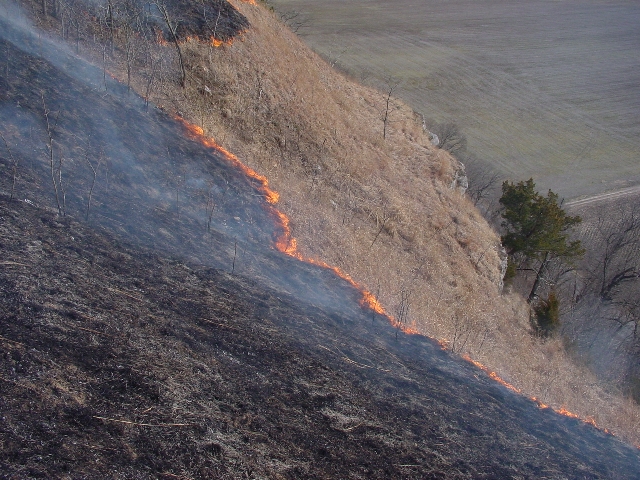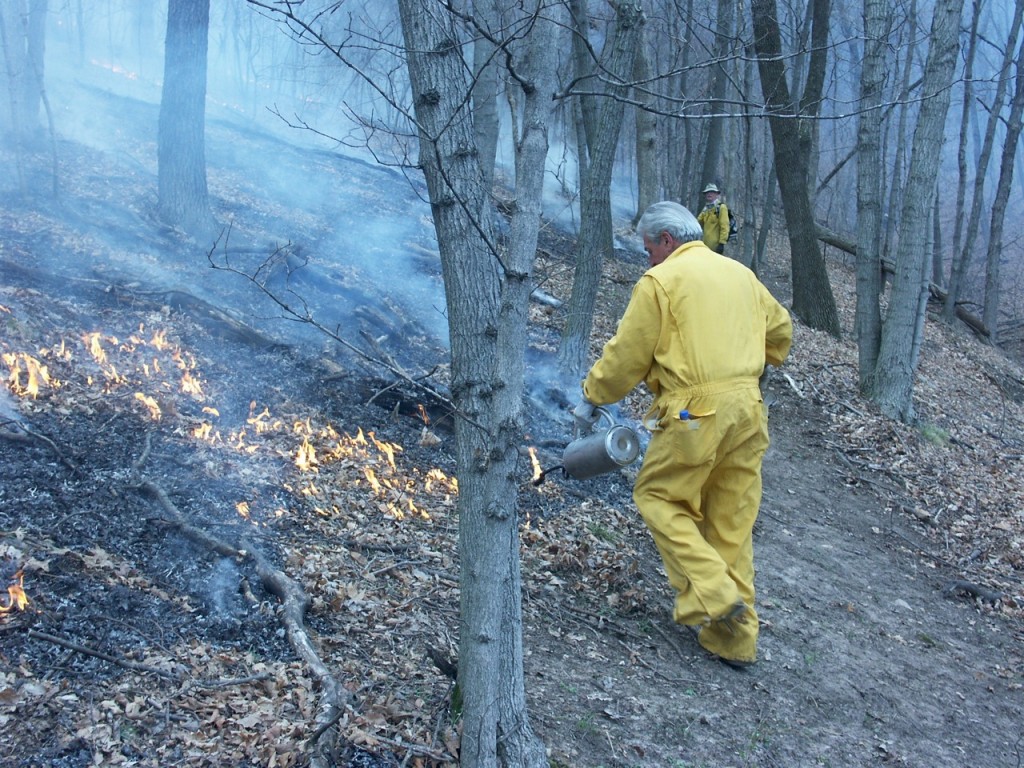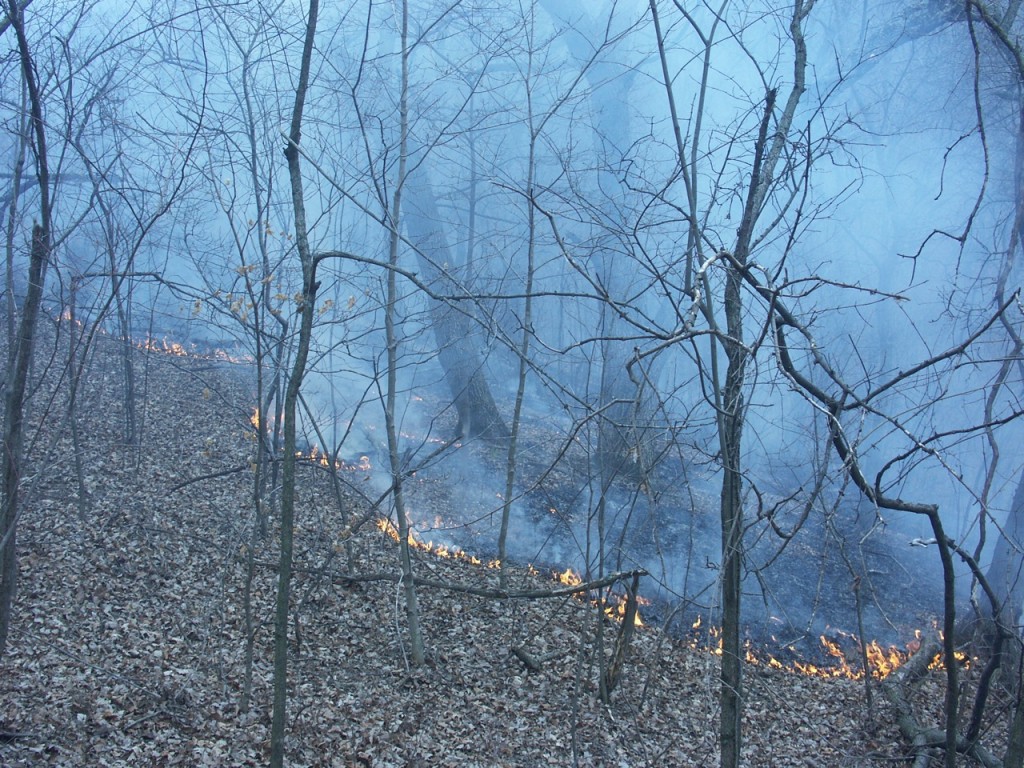Hickory Nuts Roasting on an Open Fire…
Guest author Debbie Scott Newman, Natural Areas Preservation Specialist, Illinois Nature Preserves Commission, explains the importance of prescribed fire:
Jack frost nipping at your nose. Ahh, the sounds of the crackling fire. Twigs and logs giving off that familiar smoky aroma. And the warm comforts of glowing embers amidst the chilly air. It all brings me right back to the previous season. I just love it.
Oh, sorry. I’m not talking about a fire in the woodstove or fireplace. (Well, I love that too.) I’m describing those fires creeping down a wooded slope of Salt Lick Point Land and Water Reserve or White Rock Nature Preserve. Fires intentionally lit to burn across a defined area of the landscape. As a prescribed burn practitioner for 24 years, these sensory memories pull me right back into the burn ‘season’, which usually extends from mid-October to early April when the landscape vegetation is dormant. Once you’re at a fire, it’s hard to forget the experience.
Sitting around the Christmas table my cousin quips, “What? You set fire to 100 acres? Why do you do that? Are you crazy!?” As I’ve done with hundreds of people over the years, I try to explain the why’s of burning the landscape, and invariably express those sentimental sights and sounds of being at a fire.
The why—or the benefits of applying fire to our woods, prairies and wetlands—has its foundations in ecological and human history, and would take a tome to explain. Suffice it to say Native Americans and early farmers and settlers harnessed the power of fire to manipulate the landscape, drive game, prepare for crop planting, kill bugs, and other things we may know little about. The landscape manipulation was really more of working with nature to maintain natural communities or native habitats as they had been for thousands of years. This is what we continue to seek to do today.
Applying fire to our southwest Illinois wildlands is vitally important for the diverse ecosystems that have graced our area since the last Ice Age. Among these are oak-hickory forests, hill prairies and limestone glades (both a grassland-dominated habitat), and wetlands and marshes. All of these natural communities are fire-adapted—they have evolved to thrive with fire. In fact, woodlands, prairies and glades, must have fire to exist for the long-term.
When we apply fire to the landscape today, a set of objectives determines our motivation and course of action. The benefits vary. Here are the most important ones:
While in dry years fire might have historically traversed through all the forest in a given area, it was the south- and west-facing, oak-hickory dominated woodlands that would have seen more regular and much hotter fires. Oak trees in particular, have thick, corky bark that protects them from the effects of fire. Maple trees, on the other hand, have a very thin bark and are quite susceptible to the effects of fire, even on medium-diameter trees. They historically thrived in the moister, shaded ravines and north-facing slopes. Oaks need sunlight for successful reproduction and growth, whereas maples are quite shade tolerant. Today, after 60 years of fire suppression policies, the oak forests in the eastern U.S. (including IL) are converting to maple-dominated forests. And once maples get established, the oaks can no longer germinate under their shade. Applying hot fire to sites where the canopy is dominated by oaks but the seedling/sapling layer—the next generation of forest—is all maple can assist with rebalancing the woods back to a healthy oak forest.
Burning the woods is also important for reducing years or decades of leaf litter. Of course leaf litter is a key part of any forest, but deep layers decay slowly on their own, and over time can become so thick that they snuff out spring and summer wildflowers. The summer wildflowers, too, need sunlight and reducing some of the shrub/young tree layers of the forest helps sustain wildflower diversity—and thus protecting wildlife diversity.
Hill prairies and limestone glades are both habitats dominated by a mixture of grasses and wildflowers, both of which must have sunlight to survive. These highly complex natural communities are quite rare in Illinois. Only about 500 acres of high quality hill prairie remains statewide! Fire helps to reduce/retard the quantity of woody plants, particularly cedar trees and various shrubs in prairies and glades. Unfortunately decades of fire suppression have left these communities also struggling from imbalance, much like the oak forests. Most prairies would need very hot fire several years in a row to completely eliminate woody invaders. Because this is hard to accomplish, we use mechanical control (cutting) in combination with burning.
Burning accomplishes other critical tasks in prairies and glades. Prairies can harbor over 100 species of wildflowers, but still, they are dominated by grasses. In particular, grasses that grow in thick bunches, leaving substantial thatch in winter. When spring arrives and the plants emerge from dormancy, they must push through these thick mats of dead material. Over time, the thatch starts to smother out plants (including the grasses themselves), and diversity and abundance of wildflowers and grasses declines. Burning eliminates the thatch, providing lots of ‘space’ for things to spread out and grow.
A similar scenario is found in wetlands. These natural communities, though, historically would have burned less, usually only in drier years like we had in 2012. But in those years, fires can reduce or eliminate cattail and other emergent vegetation thatch that has accumulated and prevented new plants from thriving in the wetland.
In all habitats, returning nutrients to the soil in a form more immediately available for plant uptake is a large benefit of fire. Rather than nutrients such as potassium and phosphorus being slowly released through decay of dead plant matter, burning quickly delivers it—as soon as the first rains after a fire—for plants to efficiently utilize. One of the most amazing sights is to go to a prairie in May or June, after a fire, and witness the explosion of blooming flowers. The indirect benefit of the fire is that this increased flowering results in more seed production, which in turn promotes more propagation throughout the prairie. Fires also affect soil ph and increase soil organism activity, both of which are delicately intertwined with a healthy, sustaining prairie or woodland. And earlier soil warming allows for longer growing conditions and thus more vigorous plant growth.
There are many things fire can do that might directly make us humans happy. It can reduce tick and chigger populations (Yea!!!), can knock back poison ivy, can improve morel production, and can make it easier to walk through the woods and prairies. And it can provide us with that wonderful seasonal aroma, sights and sounds of, well, hickory nuts and acorns roasting and popping.
Clifftop, a local nonprofit organization, is focused on preserving and protecting area bluff lands.
A version of this article appeared in the 18 January 2013 edition of the Monroe County Independent and in the January 2013 edition of Clifftop’s newsletter, Bluffviews.
© 2013 all content rights reserved, Clifftop NFP.
Comments are currently closed.



